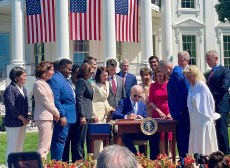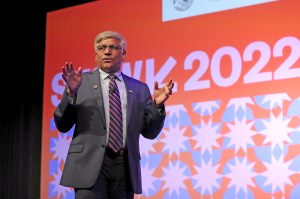NSF tech directorate tasked with boosting U.S. competitiveness needs congressional funding

The National Science Foundation’s new Technology, Innovation and Partnerships Directorate needs funding contained within the White House’s fiscal 2023 budget proposal and bipartisan competitiveness legislation in order to grow.
TIP would see $880 million if the Biden budget is passed as is, an unlikely prospect, and $29 billion over the next five years if the America COMPETES Act, which the Senate sent to the House on Monday, becomes law.
NSF leadership announced the creation of the TIP Directorate in anticipation of the latter on March 16, but additional resources are critical for executing its mission to accelerate development of emerging technologies and resulting markets and ensure U.S. global leadership in the process.
“We are demonstrating the value of what we can accomplish and what the nation needs at this very important moment,” NSF Director Sethuraman Panchanathan told FedScoop. “We are making the case knowing that there is strong bipartisan support, so I think we’re hoping for a good outcome there.”
While Panchanathan wouldn’t comment on the pending legislation, he said funding in the fiscal 2022 budget allowed NSF to bring its translation portfolio under the TIP Directorate. Translation involves turning the results of NSF’s explorative research into innovations benefiting the U.S. economy and society, and the director wants to supercharge that process.
More NSF programs will be brought under the TIP umbrella and new ones created as it expands to cover “the set of key technologies” for U.S. competitiveness, said Erwin Gianchandani, assistant director for TIP and the directorate’s leader. The America COMPETES Act identifies 10 key technologies, some of which are sure to make TIP’s list: artificial intelligence and machine learning, high-performance computing and semiconductors, quantum information science, robotics, disaster prevention, advanced communications, biotechnology, data storage and management, advanced energy, and advanced materials.
“Exactly which areas we focus on is sort of a work in progress as we step through this and really subject to the availability of funding,” Gianchandani said.
He expects his directorate may collaborate with the National AI Research Institutes he had a hand in standing up in his previous role as deputy assistant director for computer and information science and engineering, as well as the Quantum Leap Challenge Institutes. Other NSF programs that stand to benefit are the Small Business Innovation Research, Small Business Technology Transfer, Innovation Corps and Partnerships for Innovation programs.
Unique to the TIP Directorate will be the establishment of innovation engines that combine research, entrepreneurship and workforce development to accelerate industries regionally. Gianchandani attended the launch of a 10-year, $100 million partnership with Intel to research and educate the workforce in Ohio on semiconductor design and manufacturing, and help the U.S. regain leadership in the sector, one day after the TIP Directorate’s announcement.
“How do you get to where you have that level of innovation and engagement taking place so that it can really transform the community, region and ultimately their economies all across the country?” Gianchandani said.
TIP partnerships will not only involve industry, academia and nonprofits but state, local and tribal governments; communities of practice and minority serving institutions.
The directorate’s launch was a year and a half in the making, but its sustainment will hinge on its ability to coordinate with the other NSF directorates and lawmakers interested in accelerating the agency’s work.
“As much as this is a directorate,” Gianchandani said. “I’d argue it’s even more a framework for all of NSF to really be thinking about.”





